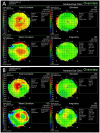Early wound healing and refractive response of different pocket configurations following presbyopic inlay implantation
- PMID: 28235010
- PMCID: PMC5325226
- DOI: 10.1371/journal.pone.0172014
Early wound healing and refractive response of different pocket configurations following presbyopic inlay implantation
Abstract
Background: Presbyopic inlays have mostly been implanted under a corneal flap. Implantation in a pocket has advantages including less postoperative dry eye and neurotrophic effect, and better biomechanical corneal stability. This study investigated the effect of different pocket and flocket dimensions on corneal stability and refractive power after Raindrop™ implantation, and the associated wound healing response.
Methodology: Ten New Zealand White rabbits had bilateral pocket Raindrop™ implantation. Eyes were allocated to 4 groups: pockets with 4mm, 6mm, and 8mm diameters, and 8mm flocket. They were examined pre-operatively, at day 1, weeks 1, 2, 3 and 4 post-surgery with anterior segment optical coherence tomography, corneal topography and in-vivo confocal microscopy. After euthanasia (week 4), CD11b, heat shock protein (HSP) 47 and fibronectin corneal immunohistochemistry was performed.
Results: Corneal thickness (mean±SD) increased from 360.0±16.2μm pre-operatively to 383.9±32.5, 409.4±79.3, 393.6±35.2, 396.4±50.7 and 405±20.3μm on day 1, weeks 1,2,3 and 4 respectively (p<0.008, all time-points). Corneal refractive power increased by 11.1±5.5, 7.5±2.5, 7.5±3.1, 7.0±3.6 and 6.3±2.9D (p<0.001). Corneal astigmatism increased from 1.1±0.3D to 2.3±1.6, 1.7±0.7, 1.8±1.0, 1.6±0.9 and 1.6±0.9D respectively (p = 0.033). CT, refractive power change and astigmatism were not different between groups. The 8mm pocket and 8mm flocket groups had the least stromal keratocyte reflectivity. CD11b, fibronectin or HSP47 weren't detected.
Conclusions: Anatomical and refractive stability was achieved by 1 week; the outcomes were not affected by pocket or flocket configuration. No scarring or inflammation was identified. The 8mm pocket and flocket showed the least keratocyte activation, suggesting they might be the preferred configuration.
Conflict of interest statement
Figures









References
MeSH terms
Substances
LinkOut - more resources
Full Text Sources
Other Literature Sources
Research Materials
Miscellaneous

